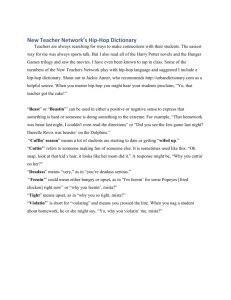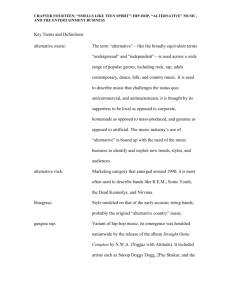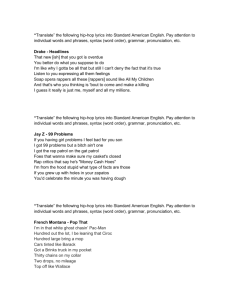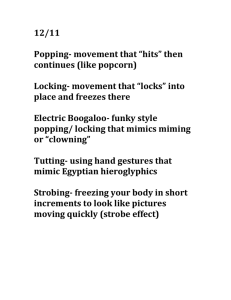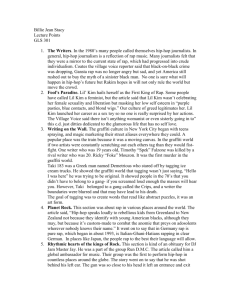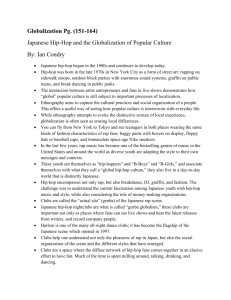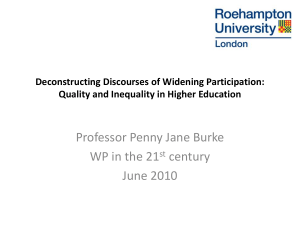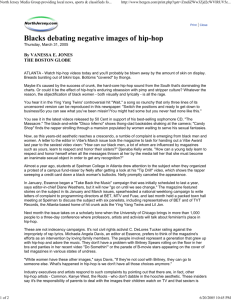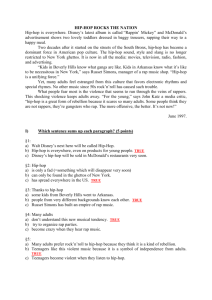(I Can) Feel the Pulse
advertisement
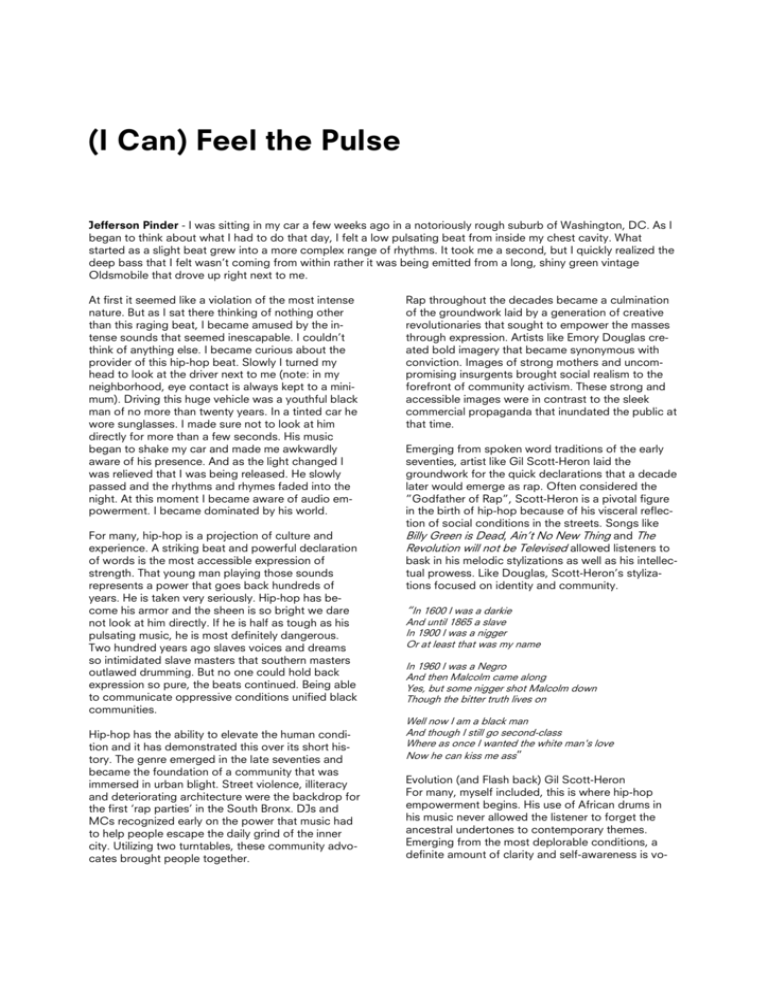
(I Can) Feel the Pulse Jefferson Pinder - I was sitting in my car a few weeks ago in a notoriously rough suburb of Washington, DC. As I began to think about what I had to do that day, I felt a low pulsating beat from inside my chest cavity. What started as a slight beat grew into a more complex range of rhythms. It took me a second, but I quickly realized the deep bass that I felt wasn’t coming from within rather it was being emitted from a long, shiny green vintage Oldsmobile that drove up right next to me. At first it seemed like a violation of the most intense nature. But as I sat there thinking of nothing other than this raging beat, I became amused by the intense sounds that seemed inescapable. I couldn’t think of anything else. I became curious about the provider of this hip-hop beat. Slowly I turned my head to look at the driver next to me (note: in my neighborhood, eye contact is always kept to a minimum). Driving this huge vehicle was a youthful black man of no more than twenty years. In a tinted car he wore sunglasses. I made sure not to look at him directly for more than a few seconds. His music began to shake my car and made me awkwardly aware of his presence. And as the light changed I was relieved that I was being released. He slowly passed and the rhythms and rhymes faded into the night. At this moment I became aware of audio empowerment. I became dominated by his world. For many, hip-hop is a projection of culture and experience. A striking beat and powerful declaration of words is the most accessible expression of strength. That young man playing those sounds represents a power that goes back hundreds of years. He is taken very seriously. Hip-hop has become his armor and the sheen is so bright we dare not look at him directly. If he is half as tough as his pulsating music, he is most definitely dangerous. Two hundred years ago slaves voices and dreams so intimidated slave masters that southern masters outlawed drumming. But no one could hold back expression so pure, the beats continued. Being able to communicate oppressive conditions unified black communities. Hip-hop has the ability to elevate the human condition and it has demonstrated this over its short history. The genre emerged in the late seventies and became the foundation of a community that was immersed in urban blight. Street violence, illiteracy and deteriorating architecture were the backdrop for the first ‘rap parties’ in the South Bronx. DJs and MCs recognized early on the power that music had to help people escape the daily grind of the inner city. Utilizing two turntables, these community advocates brought people together. Rap throughout the decades became a culmination of the groundwork laid by a generation of creative revolutionaries that sought to empower the masses through expression. Artists like Emory Douglas created bold imagery that became synonymous with conviction. Images of strong mothers and uncompromising insurgents brought social realism to the forefront of community activism. These strong and accessible images were in contrast to the sleek commercial propaganda that inundated the public at that time. Emerging from spoken word traditions of the early seventies, artist like Gil Scott-Heron laid the groundwork for the quick declarations that a decade later would emerge as rap. Often considered the ”Godfather of Rap”, Scott-Heron is a pivotal figure in the birth of hip-hop because of his visceral reflection of social conditions in the streets. Songs like Billy Green is Dead, Ain’t No New Thing and The Revolution will not be Televised allowed listeners to bask in his melodic stylizations as well as his intellectual prowess. Like Douglas, Scott-Heron’s stylizations focused on identity and community. “In 1600 I was a darkie And until 1865 a slave In 1900 I was a nigger Or at least that was my name In 1960 I was a Negro And then Malcolm came along Yes, but some nigger shot Malcolm down Though the bitter truth lives on Well now I am a black man And though I still go second-class Where as once I wanted the white man's love Now he can kiss me ass” Evolution (and Flash back) Gil Scott-Heron For many, myself included, this is where hip-hop empowerment begins. His use of African drums in his music never allowed the listener to forget the ancestral undertones to contemporary themes. Emerging from the most deplorable conditions, a definite amount of clarity and self-awareness is vo- calized and becomes the rallying cry for many. The best hip-hop emerged from young blacks that had something important to say. Taking cues from organized social groups, like the Black Panther Party many early rap artists’ found inspiration from the previous generations of activists. As the phenomenon of DJs spinning/scratching and MCs ‘spitting’ on the mic, evolved, so did the complexity of the message. First and foremost this music offered black youth a voice. Sometimes the themes were light and carefree like Sugar Hill gangs Rapper’s Delight (1979) and other songs offered a critique of the establishment or a ‘sound off’ of their experiences. We got to pump the stuff to make us tough from the heart It's a start, a work of art To revolutionize make a change nothin's strange People, people we are the same No we're not the same Cause we don't know the game What we need is awareness, we can't get careless You say what is this? My beloved lets get down to business Mental self defensive fitness (Yo) bum rush the show You gotta go for what you know Make everybody see, in order to fight the powers that be Lemme hear you say. Fight the Power Fight the Power, Public Enemy (1988) In the 1980’s, Public Enemy was introduced to mainstream American society in the Spike Lee movie Do the Right Thing. They had been recording their socially inspired Hip Hop since 1982, but this was the first time the music was used as a backdrop to a widely distributed movie dealing with themes of empowerment. Fear of a Black Planet showed identity in full force. Taking a page from Black Panther propaganda, Chuck D became the new voice of black empowerment. Chicago Tribune critic Greg Kot praised Fear of a Black Planet and wrote: ‘’Public Enemy affirms that it is not just a great rap group, but one of the best rock bands on the planet-black or otherwise.’’ In his review, Kot analyzed Chuck D's lyrical themes and messages throughout the album, and writes: “It's fear that divides us,; understand me better and you won't run. 'Fear of a Black Planet' is about achieving that understanding, but on Public Enemy's terms. In presenting their view of life from an Afro-centric, as opposed to Eurocentric, perspective, Public Enemy challenges listeners to step into their world.” Fear of a Black Planet brought to hip-hop respect from critics, millions of new fans and passionate debate over its political content in popular music. The album signaled the coupling of a strongly political message with hip-hop music. Sampling speeches from Martin Luther King, Jr. and pulling political issues from the front pages of the newspaper, their music was not only relevant but also inspirational for a new generation of youth who were experiencing urban violence and a crack epidemic that was causing division and havoc in black communities all over the country. Public Enemy also challenged mainstream American icons and offered truthful knowledge that Black Americans had talked about for years. As the rhythm designed to bounce What counts is that the rhymes Designed to fill your mind Now that you've realized the prides arrived Fight the Power, Public Enemy’s biggest commercial success typifies a hip-hop’s rallying cry to get involved. The most compelling aspect of the music is the strength it projects as a unifying call for action. Almost simultaneously West Coast groups like NWA (Niggaz with Attitudes) challenged their audience in a grittier style, which they claimed to be “Reality Rap”, but in subsequent years was renamed “Gangsta Rap”. When N.W.A came out with their second album, Straight Outta Compton, it not only traumatized the nation, but it surprised the hip-hop community as well. Unlike Boogie Down Productions or Public Enemy who came raw, but gave hope in their music, N.W.A displayed the mentality of the L.A. gangbanger who was hopeless, ignorant, materialistic, and infused with hatred for himself and others. A nigger with an attitude is what they personified and they captured the anger of the last 40 plus years of Blacks living in South Central L.A. The gang warfare and the coldness that the lifestyle brought about turned many men into monsters. Founded by former drug dealer Easy E, the group’s style of raw social commentary was revolutionary in the genre. Straight Outta Compton introduced the public to songs like Fuck the Police which protested against police brutality and violence in LA. As the FBI sent letters and Parental Advisory labels warned the public of the message, the group’s popularity and notoriety soared. The public understood that the sacred role of the artist in the community was not to maintain the status quo, but to challenge perceptions of authority and power. NWA and Public Enemy would represent two ends of the spectrum in empowerment but the impetus for both was rooted in the same vein. NWA spoke out against police brutality, but also in first person, gave the world the destructive mentality of anger, aggression, misogyny, brotherhood and violence of West Coast gang culture. On the other hand, Public En- emy represented Black Nationalism and radical philosophies that stemmed from The Nation of Islam and the Black Panthers. But for many early hip-hop artists, empowerment meant more than social fisticuffs. Almost in direct response to the gritty intensity of “Gangsta Rap”, middle-class youth from Brooklyn New York began to find their voices by sampling old jazz beats and creating lyrics that reflected the spiritual journey of blackness. While Public Enemy and NWA were creating music that directly reflected a community in crisis, De La Soul and A Tribe Called Quest were using witty music to fulfill a more eclectic view of the black experience. This indeed was an empowerment of a passive sort, but equally important. Let’s not forget about rap artists like Missy Elliot and Jean Grae that are blazing forward in a predominately male genre of music. With the distinction of bringing a gender perspective in a style that has notorious reputation for being misogynist, they are in the trenches working from within to expand the understanding and public face of hip-hop. Their work is often minimized but the power of their lyrics tells a different story. For all my niggaz that smoke a pack a day For all my niggaz hold the bottle drink the pain away: what type of life is this? For all my niggaz that getn' the cash, and all my niggaz that chill on the ave Lets keep livin. For all my niggaz drink the pain away For all my niggaz smoke a pack of newports a day: what type of life is this? For all my niggaz that getn' the cash, and all my niggaz that chill on the ave Lets keep livin. Keep Livin, Jean Grae(2004) Where is hip-hop now? Who the hell knows? Artists like Lupe Fiasco, Talib Kweli and Mos Def are carrying the torch for a genre that at times appears to be in decline. As the general public often confuses mainstream popular hip-hop derivatives for the ‘real thing’ it’s important to remind folks that there are many facets of what we now call hip-hop. For some hip-hop artists, the primary motivation is status and money. You only have to watch a series of videos on MTV to get a glimpse of the priorities of commercial rap. And for this we see a huge decline in quality. For many years, dynamic music videos introduced new audiences to the urban style; now formulaic videos saturate limited airtime and give the public at large a stereotypical view of black culture. But on the contrary in African countries like Senegal, you see the dawn of a different kind of world-beat hip-hop that is more similar to the old American Style. Musicians like Didier Awadi, a rap pioneer from Dakar combines music with his social advocacy. Rap artist like Awadi are beginning to show the real potential of the medium to transform thought. Beginning his career in the streets of Dakar he cites influences like Grand Master Flash and Sugar Hill Gang. Rapping in his native Wolof he unleashes a new connectivity to the style of hip-hop. His words echo empowerment and change throughout the African continent. Combining traditional West African instruments to his hip-hop beats, Awadi has become an international phenomenon that is a representation of what rap can be. “Our music for us is a weapon of mass education to fight all of the injustices that we face everywhere, everyday,”- he declared in a recent interview on National Public Radio. Awadi demonstrates how hip-hop is finding its way to new populations around the world. What started as party music in the ghettos in the South Bronx, has found its way back home. In Africa, the music is closer to the roots than ever before. The truth is that there is a global movement that is really beginning to tap into what this music can really become. So perhaps one day as I travel to a remote shantytown in Dakar, the hip-hop music that might be playing out of a boom box in a flower basket of a slow moving bicycle might ultimately be the armor that a black man might need to lift himself out of abject poverty. That would be the real revolution that founding fathers of American hip-hop never envisioned but creatively inspired. Jefferson Pinder is a Washington based video artist and professor Art and Theatre Theory at the University van Maryland. He has a background in theatre and mixed media, with a large interest in history and cultural expressions of the Afro-American identity. The exhibition (I can) Feel the Pulse will assemble three of Pinder’s video works, which concerns his recent work Mule and a bit older Car wash en Invisible man.
